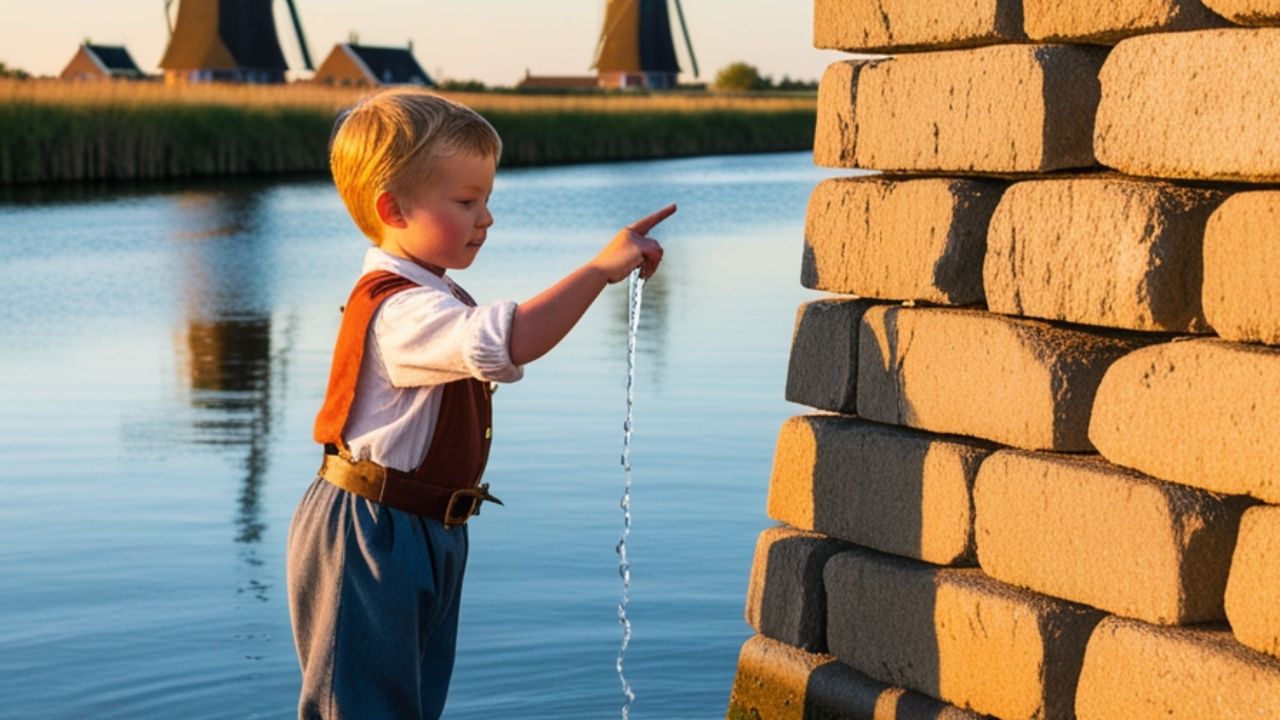The story tells about a small boy in Holland who saw water leaking from a wall called a dike. He quickly put his finger in the hole to stop the water. His brave act saved his town from a big flood and danger.
This simple tale shows how one small action can prevent a great problem. The boy’s courage and fast thinking helped everyone stay safe. People remember this story to learn about being responsible and taking action before troubles grow too big.
Today, many use this old story as an example of quick help in emergencies. The lesson teaches that even small efforts can stop large troubles. It reminds us that caring and brave choices protect people and keep peace in our world.
Common Usage
- Emergency Help – Used when someone acts quickly to stop danger or loss.
- Quick Fix – Describes a short-term solution to a big problem.
- Early Action – Means solving a small issue before it grows.
- Temporary Stop – Shows effort to delay or control trouble.
- Preventive Step – Reminds people to take care before harm happens.
The Tale of the Little Dutch Boy
A brave little boy from Holland saw water coming through a wall near his town. The Dutch boy used his finger to stop the leak and stayed there all night. His brave heart saved the people from a big flood.
This kind act showed great courage and care for others. The story became famous around the world. It teaches that small actions can save many lives. The boy’s quick thinking and kindness remind everyone to help and protect their community.
Hans Brinker vs. The Little Dutch Boy
- Hans Brinker is the main character in Mary Mapes Dodge’s book The Silver Skates.
- The Little Dutch Boy appears in a short story within the same book.
- Hans dreams of winning silver skates through hard work and honesty.
- The Dutch boy saves his town by blocking a leak in a dike.
- Both stories teach courage and kindness, but they tell different lessons.
The Reality of Dike Systems
In the Netherlands, dikes are crucial structures that protect low-lying areas from flooding. The idea of a single finger preventing a dike breach is symbolic rather than practical.
See also : Leapt vs Leaped: Key Grammar Difference Explained
Dike Failure and Repair

A dike is a wall that keeps water away from land. Sometimes heavy rain or strong waves make it break. When this happens, water can rush into towns and farms, causing harm to people, homes, and animals living nearby.
Workers fix the broken wall using sandbags, stones, and strong machines. These tools make the repair faster and safer. Engineers also build stronger walls to stop more damage later. Caring for dikes helps protect land, families, and nature from floods.
- Dikes are strong walls built to keep sea water away from land.
- Heavy rain or strong waves can cause cracks or breaks in them.
- When a wall breaks, water floods homes and farms nearby.
- Workers use sandbags, rocks, and machines to fix the damage.
- Engineers build stronger walls to stop future floods and protect people.
The 1953 North Sea Flood: A Real-Life Parallel
The North Sea flood happened in 1953 and covered parts of the Netherlands, Belgium, and England. Strong winds and high water broke many walls, flooding homes and farms. Many people lost their houses, and the country faced great sadness and loss.
After the disaster, helpers worked day and night to save lives and rebuild towns. The tragedy taught everyone the importance of strong sea walls and safety plans. It showed how teamwork and care can help people recover from hard times and protect the future.
Skipper Arie Evergroen’s Heroic Act
During the great flood, Skipper Arie Evergroen showed real bravery. He guided his ship toward a broken sea wall and blocked the rushing water. His quick and brave choice stopped the flood from spreading and saved many homes and people from danger.
The townspeople called him a true hero for his kind act. His courage and fast thinking helped protect families and land from the storm. The heroic act reminded everyone that one person’s strength and care can make a big difference in saving lives.
Impact and Aftermath
The impact of the great flood was very painful for many families. Water destroyed houses, farms, and animals. People worked hard to find food and shelter. The country felt deep sadness as they tried to rebuild their homes and start new lives.
After the water went down, helpers and builders repaired roads and walls. The aftermath taught everyone to make stronger protection against future storms. It also showed how kindness, teamwork, and hope can bring people together after facing such hard and scary times.
- The flood caused great damage to homes, farms, and roads.
- Many families lost their houses and had to move to safe places.
- Helpers and builders worked hard to repair broken areas.
- The aftermath taught people to build stronger flood walls.
- Everyone learned the value of teamwork and hope after the disaster.
Modern-Day Usage of “Finger in the Dike”
Today, the idiom is used metaphorically across various contexts to describe a temporary or emergency measure.s
Examples in Contemporary Discourse

- In politics, it describes quick actions taken to control sudden problems.
- In business, it means short fixes used to stop financial loss.
- In technology, it shows emergency patches for software issues.
- In healthcare, it stands for temporary steps to manage crises.
- In education, it teaches solving small troubles before they grow big.
See also : Dry Snitching: Meaning, Examples, and How to Respond
Conclusion
The lesson from this story teaches that even small acts can bring big change. A tiny step taken with courage can save lives and protect others. Every person has the power to do something good, just like the brave boy in the tale.
In the end, the story reminds people to stay strong and kind during trouble. The message gives hope that teamwork, love, and care can make the world safer. Helping others in need makes life better for everyone and keeps hearts full of peace.
FAQs
What does finger in the dike mean?
It means taking quick action to prevent a small problem from becoming a major disaster.
What is the story of the boy who put his finger in the dike?
It’s about a Dutch boy who saves his town by plugging a leaking dike with his finger.
Is The Little Hero of Holland a true story?
No, it’s a fictional tale popularized by Mary Mapes Dodge’s 1865 novel Hans Brinker.
Is the Dutch boy story true?
No, it’s a legend, not based on real events, but symbolizes bravery and quick thinking.

Join Bibcia on a journey to master English grammar. Discover easy lessons, writing tips, and practical examples designed to make learning grammar simple and effective.










